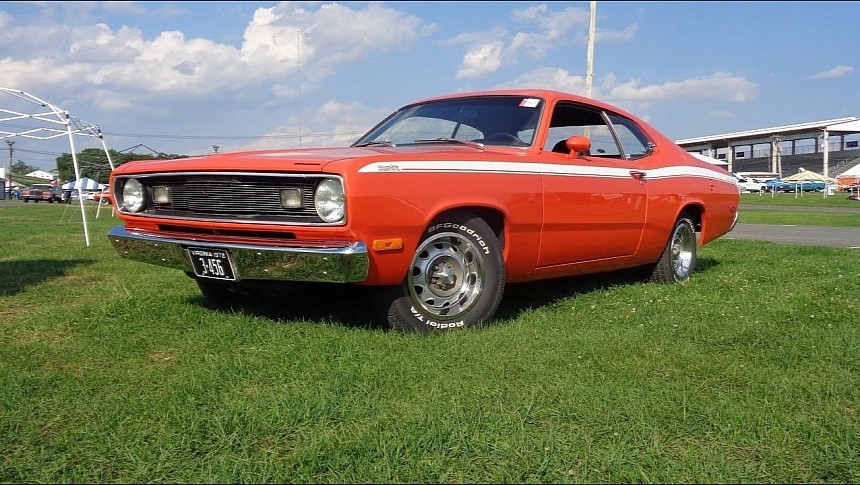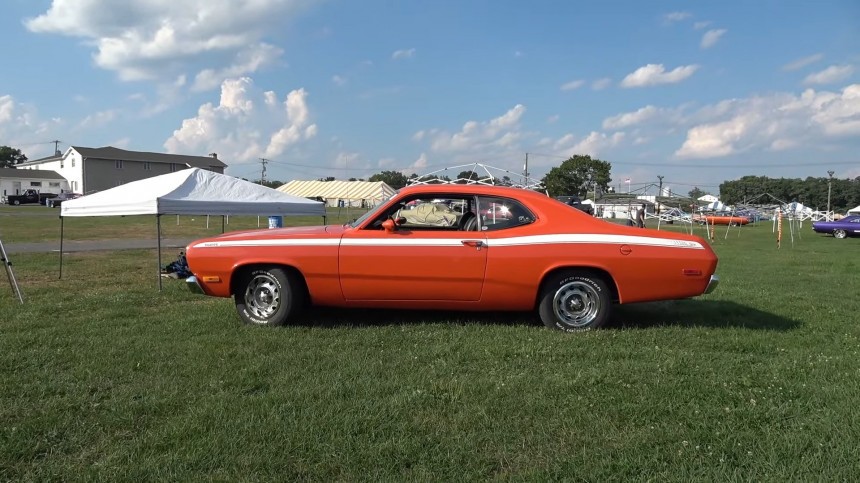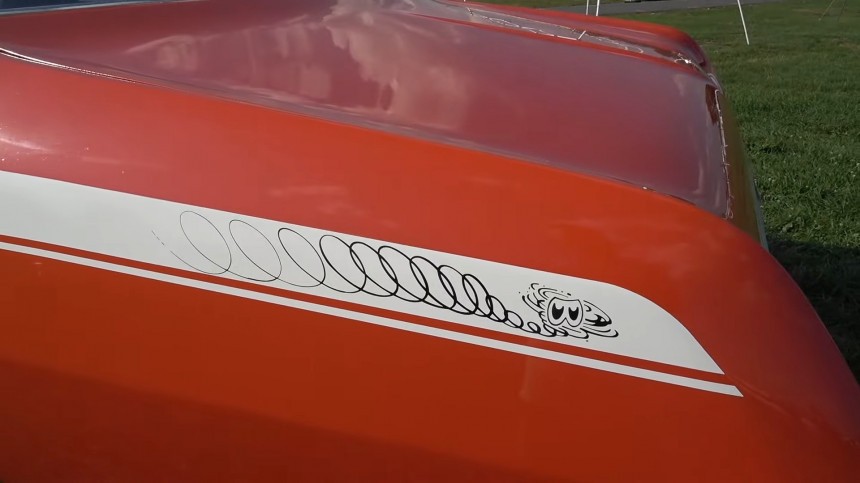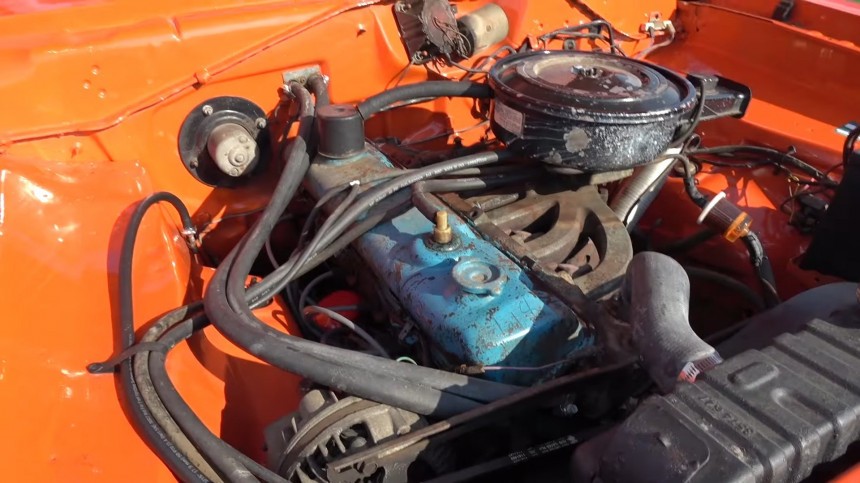Arriving in September 1969 as the A-body replacement for the up-shifted Barracuda (which moved to the E-Body Platform from 1970 onward), the Plymouth Duster was a magnificent display of scarcely funded ingenuity that worked wonders in the sales charts. It did so well that it indirectly led to the premature demise of the freshly conceived muscle car (the Barracuda was retired at the end of 1974).
The Duster nameplate was a sporty version of the 1970 Plymouth Valiant (the company’s trusted compact automobile since 1960), and it hit a home run of a sales performance. In its inaugural year, the new Plymouth Valiant Duster moved 268,000 units off the assembly lines, over 2.5 times more than the previous year’s results of 107,000.
Also, 1970 was the only year the new model would carry both names; from 1971 until its demise in 1976, the Plymouth was simply named ‘Duster.’ The big hit in the money-getting sector wasn’t just a one-yea featr: the Duster kept climbing the ladder of market share every year until 1974, when it peaked at almost 460,000 examples.
The biggest sales point for the little car was its low price – purchase, use, and maintenance – and large-scale parts availability. And in one particular case, it offered significant performance on a tight budget.
We are talking about the famous Duster 340, the Mopar pocket rocket that gave the Barracuda a run for its money. Chrysler execs from the early seventies had difficulty accepting that a small Duster with the punchy 340-cubic-inch (5.6-liter) V8 was a much better deal than a full-blown pony car, namely the Barracuda.
Here are the cold, hard facts: When the E-bodies were in the wraps, the reasonably-priced Chevrolet Nova (carrying the 327 small-block) was the car to beat in a bone-stock quarter-mile contest. Unfortunately for Plymouth’s expensive pony from 1970, the Barracuda, with its heavier body, was not up to the job unless it packed serious firepower – think HEMI or 440 Super Commando.
That’s not to say that the smaller Chrysler motors weren’t up to the job, but the Barracuda hid a bootlegging secret under its body. The car was designed and built to take in any Mopar powerplant, from the 198 Six to the enormous elephant and its 426 cubic inches (seven liters).
The bulkier body held the Barracuda back, but the Duster fully seized the opportunity and shot ahead in customer appeal and sales, thanks to its 340 V8 option. This is how the blue-collared Duster 340 outscored the Barracuda 340/383 every single year until the fishy pony was sacked at the end of 1974.
The Duster also made Mother Mopar proud with its other variants, the wallet-friendly Slant Sixes and the 318 CID (5.2-liter) V8. Particularly the robust six-cylinder, which had proven itself over and over for an entire decade before the Duster took the stage.
Chrysler built two variants of the 30°-tilted-to the-right inline-six powerplants for automobile use, the 198 cubic-inch (3.2 liters) and the 225 CID (3.7-liter). Both engines were equally famous for their sturdiness, reliability, ruggedness, and simplicity. Overall, they were also easy to work on, thanks to a canyon of engine bay surrounding them.
An often-told lore about the ‘leaning tower-of-power’ is that the engine would outlast its car a few times over – but that’s a biased statement. True, the engine was tough as nails and ran and ran without hesitation, giving all it had day in and day out. But equally valid is that the bodies of the cars were magnificently biodegradable before the concept even existed.
That’s a metaphor for the rate at which sheet metal oxidation ate away the Dusters, effectively turning them into Plymouth ‘Rusters’ unless proper care was given. When I say proper care, I use the car in the attached video as an example of how to preserve an automobile for 50+ years.
This 1972 Plymouth Duster has the workhorse Slant Six 225-cube in it, churning 110 hp and 185 lb-ft (112 PS, 251 Nm) for that trusty three-speed TorqueFlite auto tranny. Please note that from 1971 onward, American carmakers were reporting their engines’ outputs in accordance with the Society of Automotive Engineers’ net ratings.
The car’s owner bought his beloved Duster in 2000 after a 21-year-long wait. Yes, the numbers are correct, even if the Duster went out of production in 1976, three years before 1979. And no, the waiting line wasn’t that long, even for a Plymouth Duster. Here’s the deal: a young man sees a Tor Red 1972 Plymouth Duster for sale in 1979.
Call it what you will, but 21 years later, the same man sees the same car – again offered for sale, and they stayed together ever since. Sure, the sporty 340s get a lot of attention, and other Mopar Legends are instant head-turners at car shows. But how many can brag with minimal maintenance year after year and an impeccable service record, like this humble 225? The odometer reads 56,842.9 miles (91,460 kilometers), and the feisty one-barrel-carb Six punches just like day one.
Also, 1970 was the only year the new model would carry both names; from 1971 until its demise in 1976, the Plymouth was simply named ‘Duster.’ The big hit in the money-getting sector wasn’t just a one-yea featr: the Duster kept climbing the ladder of market share every year until 1974, when it peaked at almost 460,000 examples.
The biggest sales point for the little car was its low price – purchase, use, and maintenance – and large-scale parts availability. And in one particular case, it offered significant performance on a tight budget.
We are talking about the famous Duster 340, the Mopar pocket rocket that gave the Barracuda a run for its money. Chrysler execs from the early seventies had difficulty accepting that a small Duster with the punchy 340-cubic-inch (5.6-liter) V8 was a much better deal than a full-blown pony car, namely the Barracuda.
That’s not to say that the smaller Chrysler motors weren’t up to the job, but the Barracuda hid a bootlegging secret under its body. The car was designed and built to take in any Mopar powerplant, from the 198 Six to the enormous elephant and its 426 cubic inches (seven liters).
The bulkier body held the Barracuda back, but the Duster fully seized the opportunity and shot ahead in customer appeal and sales, thanks to its 340 V8 option. This is how the blue-collared Duster 340 outscored the Barracuda 340/383 every single year until the fishy pony was sacked at the end of 1974.
The Duster also made Mother Mopar proud with its other variants, the wallet-friendly Slant Sixes and the 318 CID (5.2-liter) V8. Particularly the robust six-cylinder, which had proven itself over and over for an entire decade before the Duster took the stage.
An often-told lore about the ‘leaning tower-of-power’ is that the engine would outlast its car a few times over – but that’s a biased statement. True, the engine was tough as nails and ran and ran without hesitation, giving all it had day in and day out. But equally valid is that the bodies of the cars were magnificently biodegradable before the concept even existed.
That’s a metaphor for the rate at which sheet metal oxidation ate away the Dusters, effectively turning them into Plymouth ‘Rusters’ unless proper care was given. When I say proper care, I use the car in the attached video as an example of how to preserve an automobile for 50+ years.
This 1972 Plymouth Duster has the workhorse Slant Six 225-cube in it, churning 110 hp and 185 lb-ft (112 PS, 251 Nm) for that trusty three-speed TorqueFlite auto tranny. Please note that from 1971 onward, American carmakers were reporting their engines’ outputs in accordance with the Society of Automotive Engineers’ net ratings.
Call it what you will, but 21 years later, the same man sees the same car – again offered for sale, and they stayed together ever since. Sure, the sporty 340s get a lot of attention, and other Mopar Legends are instant head-turners at car shows. But how many can brag with minimal maintenance year after year and an impeccable service record, like this humble 225? The odometer reads 56,842.9 miles (91,460 kilometers), and the feisty one-barrel-carb Six punches just like day one.








































